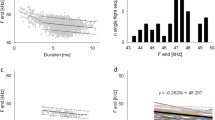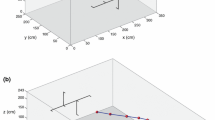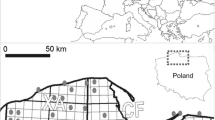Abstract
We studied the echolocation and hunting behavior of three aerial insectivorous species of bats (Vespertilionidae: Pipistrellus) in the field in order to characterize the signals used by the bats and to determine how call structure varies in relation to habitat structure (“uncluttered” versus “cluttered” space). We documented free-flying, naturally foraging wild pipistrelles in various habitats using multiflash stereophotography combined with simultaneous sound recordings. Then we reconstructed the bat's flight position in three-dimensional space and correlated it with the corresponding echolocation sequences. In all three species of pipistrelles, signal structure varied substantially. In echolocation sequences of the search phase we found a consistent association of signal types with habitat types. In uncluttered habitats (obstacles more than 5 m from the bat) pipistrelles emitted almost exclusively narrowband signals with bandwidths less than 15 kHz. In cluttered habitats (obstacles less than 5 m from the bat) they switched to signals with bandwidths of more than 15 kHz. Wideband signals were also used when the bats were turning in cluttered and uncluttered spaces and for an instant after turning away from obstacles. Prey detection occured only when the outgoing signal did not overlap with the returning echo from potential prey. The bats also avoided overlap of echoes from potential prey and obstacles. Based on the results of this study, we propose an overlap-free “window” within which pipistrelles may detect potential prey and which allows predictions of minimum distances to prey and clutter-producing objects.
Similar content being viewed by others
References
Ahlén I (1981) Identification of Scandinavian bats by their sounds (Report 6). Swedish University of Agricultural Sciences, Department of Wildlife Ecology, Uppsala, Sweden, pp 1–56
Barclay RMR (1985) Long- versus short-range foraging strategies of hoary (Lasiurus cinereus) and silver-haired (Lasionycteris noctivagans) bats and the consequences for prey selection. Can J Zool 63:2507–2515
Barclay RMR (1986) The echolocation calls of hoary (Lasiurus cinereus) and silver-haired (Lasionycteris noctivagans) bats as adaptations for long- versus short-range foraging strategies and the consequences for prey selection. Can J Zool 64:2700–2705
Cahlander DA, McCue JJG, Webster FA (1964) The determination of distance by echolocating bats. Nature 201:251–544
Emde Gvd, Menne D (1987) Discrimination of insect wingbeatfrequencies by the bat Rhinolophus ferrumequinum. J Comp Physiol A 164:663–671
Emde Gvd, Schnitzler HU (1986) Fluttering target detection in Hipposiderid bats. J Comp Physiol A 159:756–772
Fenton MB (1986) Design of bat echolocation calls: implications for foraging ecology and communication. Mammalia 2:192–203
Fenton MB (1990) The foraging behaviour and ecology of animaleating bats. Can J Zool 86:411–422
Griffin DR (1958) Listening in the dark. Yale University Press, New Haven
Griffin DR, Webster FA, Michael CR (1960) The echolocation of flying insects by bats. Anim Behav 8:141–154
Habersetzer J, Vogler B (1983) Discrimination of surface-structured targets by the echolocating bat Myotis myotis during flight. J Comp Physiol 152:275–282
Helversen Ov (1989) Bestimmungsschlüssel fur die europäischen Fledermäuse nach äußeren Merkmalen. Myotis 27:41–60
Horácek J, Hanák V (1986) Generic status of Pipistrellus savii and comments on classification of the genus Pipistrellus (Chiroptera, Vespertilionidae). Myotis 23–24:9–16
Jones (1993) Flight performance, echolocation and foraging behavior in the noctule Nyctalus noctula. Bat Res News 34:23
Kalko EKV (1991) Das Echoortungs- und Jagdeverhalten der drei europäischen Zwergfledermausarten, Pipistrelus pipistrellus (Schreber 1774), Pipistrellus nathusii (Keyserling et Blasius 1939) und Pipistrellus kuhli (Kuhl 1819), im Freiland, PhD thesis, University of Tübingen, Germany, pp 1–310
Kalko EKV, Schnitzler HU (1989) The echolocation and hunting behavior of Daubenton's bat, Myods daubentoni. Behav Ecol Sociobiol 24:225–238
Kober R, Schnitzler HU (1990) Information in sonar echoes of fluttering insects available for echolocating bats. J Acoust Soc Am 87:882–896
Limpens HJGA, Helmer W, Winden A van, Mostert K (1989) Bats and linear landscape elements. Lutra 32:1–20
Miller LA, Degn HJ (1981) The acoustic behavior of four species of vespertilionid bats studied in the field. J Comp Physiol 142:67–74
Neuweiler G (1983) Echolocation and adaptivity to ecological constraints. In: Huber F, Markl H (eds) Neuroethology and behavioral physiology. Springer, Berlin Heidelberg New York, pp 280–302
Neuweiler G (1984) Foraging, echolocation and audition in bats. Naturwissenschaften 71:446–455
Neuweiler G (1990a) Auditory adaptations for prey capture in echolocating bats. Physiol Rev 70:615–641
Neuweiler G (1990b) Foraging ecology and audition in echolocating bats. Trends Ecol Evol 4:160–166
Pye D (1980) Adaptiveness of echolocation signals in bats. Trends Neuro Sci 3:232–235
Racey PA, Swift SM (1985) Feeding ecology of Pipistrellus pipistrellus (Schreber) (Chiroptera: Vespertilionidae) during pregnancy and lactation. I. Foraging behavior. J Anim Ecol 54:205–215
Roverud RC, Nitsche V, Neuweiler G (1991) Discrimination of wingbeat motion by bats, correlated with echolocation sound pattern. J Comp Physiol A 168: 259–263
Rydell J (1986) Foraging and diet of the northern bat, Eptesicus nilssoni in Sweden, Holarct Ecol 9: 272–276
Rydell J (1990) Behavioural variation in echolocation pulses of the Northern bat, Eptesicus nilssoni. Ethology 85: 103–113
Schmidt S (1988) Evidence for a spectral basis of texture perception in bat sonar. Nature 331:617–619
Schnitzler HU (1987) Echoes of fluttering insects: information for echolocating bats. In: Fenton MB, Racey P, Rayner JMV (eds) Recent advances in the study of bats. Cambridge University Press, Cambridge, pp 226–243
Schnitzler HU, Henson OW Jr (1980) Performance of airborne animal sonar systems. I. Microchiroptera. In: Busnel RG, Fish JF (eds) Animal sonar systems. Plenum, New York, pp 109–181
Schnitzler HU, Menne D, Kober R, Heblich K (1983) The acoustical image of fluttering insects in echolocating bats. In: Huber F, Markl H (eds) Neuroethology and behavioral physiology. Springer, Berlin Heidelberg New York, pp 235–250
Schnitzler HU, Kalko E, Miller L, Surlykke A (1987) The echolocation and hunting behavior of the bat, Pipistrellus kuhli. J Comp Physiol A 161:267–274
Schumm A, Krull D, Neuweiler G (1991) Echolocation in the notch-eared bat, Myotis emarginatus. Behav Ecol Sociobiol 28:255–261
Simmons JA, Stein RA (1980) Acoustic imaging in bat sonar: echolocation signals and the evolution of echolocation. J Comp Physiol 135:61–84
Simmons JA, Lavender WA, Lavender BA Childs JE, Hulebak K, Rigden MR Sherman J Woolman B O'Farrell MJO (1978) Echolocation by free-tailed bats (Tardarida). J Comp Physiol 125:291–299
Simmons JA, Fenton MB, O'Farrell MJ (1979) Echolocation and pursuit of prey by bats. Science 203:16–21
Sum YW, Menne D (1988) Discrimination of fluttering targets by the FM-bat Pipistrellus stenopterus? J Comp Physiol A 163:249–354
Swift SM, Racey PA, Avery MI (1985) Feeding ecology of Pipistrellus pipistrellus (Chiroptera: Vespertilionidae) during pregnancy and lactation. II. Diet. J Anim Ecol 54:217–225
Weid R, Helversen Ov (1987) Ortungsrufe europäischer Fledermäuse beim Jagdflug im Freiland. Myotis 25:5–27
Zbinden K (1989) Field observations on the flexibility of the acoustic behavior of the european bat Nyctalus noctula (Schreber 1774). Rev Suisse Zool 96:335–343
Zingg PE (1990) Eine Methode zur akustischen Artidentifizierung von Fledermäusen (Mammalia: Chiroptera) und ihr Einsatz bei der Ermittlung der Artvorkommen im Val Bregaglia (GR). PhD thesis, University of Genf, Switzerland, pp 1–82
Author information
Authors and Affiliations
Additional information
Correspondence to: E.K.V. Kalko
Rights and permissions
About this article
Cite this article
Kalko, E.K.V., Schnitzler, HU. Plasticity in echolocation signals of European pipistrelle bats in search flight: implications for habitat use and prey detection. Behav Ecol Sociobiol 33, 415–428 (1993). https://doi.org/10.1007/BF00170257
Received:
Accepted:
Issue Date:
DOI: https://doi.org/10.1007/BF00170257




